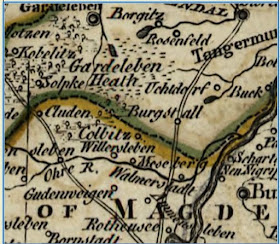So, where are the records? The answer could be as simple as doing a search on Ancestry.com or FamilySearch.org or as complex as locating a courthouse and manually searching boxes of records in a basement or attic. The reason why I decided to write about this subject is that searching for probate records is a microcosm of the entire process of locating records. If you know how to find probate records, you can use the same technique to find just about any type of record in existence.
The first step in finding any genealogically significant record is identifying the physical location of an event associated with the ancestor's death. Probate records are most likely associated with the place where the person died.
It may be necessary to do extensive research into other types of records in order to determine where the person died. The court or other entity handling the probate is the one that had jurisdiction at the time and place of the event. What I mean by jurisdiction is the ability of the court to hear a probate action. The rule is that probate actions were conducted in a court handing such cases according to one or more of the following:
- The place where the death occurs, or
- The place where the property is located, or
- The place where the deceased resided, or
- The place established by a will or other testamentary document
The import of these requirements is that probate records may be difficult to locate. They may require an extensive amount of supplementary research into the events of the deceased's life in order to establish a place to begin the search for the court records. Once the places that established for the death then it is necessary to determine the court that would've had jurisdiction at the time. For example, if the deceased died in Utah, some historical research will disclose that the county courts were established to hear probate matters.
Once you determine which court had jurisdiction over the probate matters, you must then determine the location of the court records. As I mentioned above, they could be online or in boxes in the courthouse. The records could also be stored in the state archives, state historical society, in a university special collections library, or in almost any other record storage location.
Most researchers think that by searching for a year or so around the death date, they have determined whether or not there was a probate. I suggest, that the proper way to solve both the existence of a probate action and the location of the court is to examine land and property records. If a deceased's property passed through a probate action, it is very likely that there was a deed recorded transferring property to the heirs or to a creditor. If the data is found with the designation of administrator's deed, and executor's deed or a deed of distribution, then you are put on notice that there was a probate action filed.
Unless records have been accumulated in a central repository and then digitized, finding the records will need to follow essentially the same process I outlined here.
- Identify the location of an event in the deceased's life
- Identify documents associated with the event
- Identify the location of the documents
- Search for the information needed
Due to the fact, that the online genealogical databases are adding in millions of documents on a regular basis, it is very important to continue looking online.
In discussing this topic, the question is commonly raised as to whether a very poor individual was required to have a probate action? The answer is that whether or not appropriate was required depends on the time of the event and the jurisdiction involved. Early in the history of the Americas, it was not unusual to find a probate action for someone with very little personal property. More recently, the states have established thresholds for the filing of a probate action. Very poor people generally do not have to file probate actions.



















